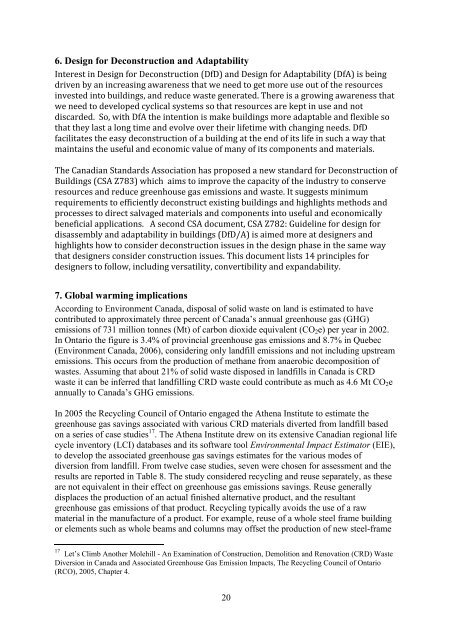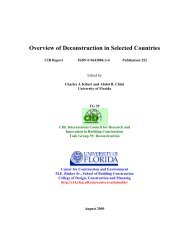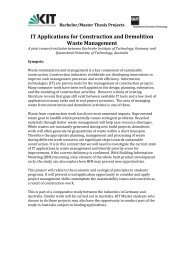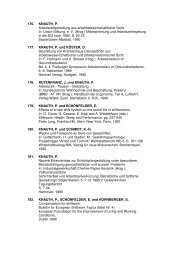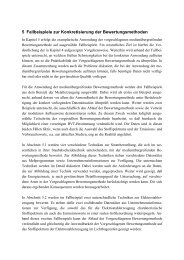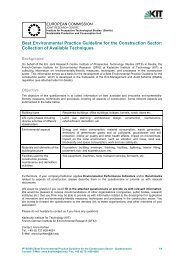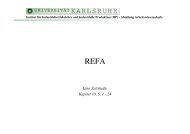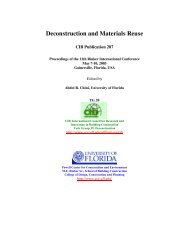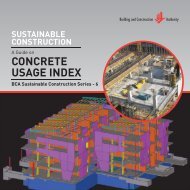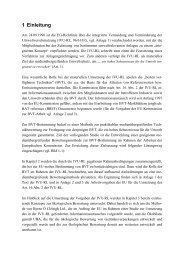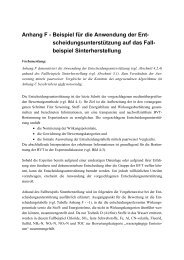Waste reduction final report -4 - Test Input
Waste reduction final report -4 - Test Input
Waste reduction final report -4 - Test Input
You also want an ePaper? Increase the reach of your titles
YUMPU automatically turns print PDFs into web optimized ePapers that Google loves.
6. Design for Deconstruction and Adaptability<br />
Interest in Design for Deconstruction (DfD) and Design for Adaptability (DfA) is being <br />
driven by an increasing awareness that we need to get more use out of the resources <br />
invested into buildings, and reduce waste generated. There is a growing awareness that <br />
we need to developed cyclical systems so that resources are kept in use and not <br />
discarded. So, with DfA the intention is make buildings more adaptable and flexible so <br />
that they last a long time and evolve over their lifetime with changing needs. DfD <br />
facilitates the easy deconstruction of a building at the end of its life in such a way that <br />
maintains the useful and economic value of many of its components and materials. <br />
The Canadian Standards Association has proposed a new standard for Deconstruction of <br />
Buildings (CSA Z783) which aims to improve the capacity of the industry to conserve <br />
resources and reduce greenhouse gas emissions and waste. It suggests minimum <br />
requirements to efficiently deconstruct existing buildings and highlights methods and <br />
processes to direct salvaged materials and components into useful and economically <br />
beneficial applications. A second CSA document, CSA Z782: Guideline for design for <br />
disassembly and adaptability in buildings (DfD/A) is aimed more at designers and <br />
highlights how to consider deconstruction issues in the design phase in the same way <br />
that designers consider construction issues. This document lists 14 principles for <br />
designers to follow, including versatility, convertibility and expandability. <br />
7. Global warming implications<br />
According to Environment Canada, disposal of solid waste on land is estimated to have<br />
contributed to approximately three percent of Canada’s annual greenhouse gas (GHG)<br />
emissions of 731 million tonnes (Mt) of carbon dioxide equivalent (CO 2 e) per year in 2002.<br />
In Ontario the figure is 3.4% of provincial greenhouse gas emissions and 8.7% in Quebec<br />
(Environment Canada, 2006), considering only landfill emissions and not including upstream<br />
emissions. This occurs from the production of methane from anaerobic decomposition of<br />
wastes. Assuming that about 21% of solid waste disposed in landfills in Canada is CRD<br />
waste it can be inferred that landfilling CRD waste could contribute as much as 4.6 Mt CO 2 e<br />
annually to Canada’s GHG emissions.<br />
In 2005 the Recycling Council of Ontario engaged the Athena Institute to estimate the<br />
greenhouse gas savings associated with various CRD materials diverted from landfill based<br />
on a series of case studies 17 . The Athena Institute drew on its extensive Canadian regional life<br />
cycle inventory (LCI) databases and its software tool Environmental Impact Estimator (EIE),<br />
to develop the associated greenhouse gas savings estimates for the various modes of<br />
diversion from landfill. From twelve case studies, seven were chosen for assessment and the<br />
results are <strong>report</strong>ed in Table 8. The study considered recycling and reuse separately, as these<br />
are not equivalent in their effect on greenhouse gas emissions savings. Reuse generally<br />
displaces the production of an actual finished alternative product, and the resultant<br />
greenhouse gas emissions of that product. Recycling typically avoids the use of a raw<br />
material in the manufacture of a product. For example, reuse of a whole steel frame building<br />
or elements such as whole beams and columns may offset the production of new steel-frame<br />
17 Let’s Climb Another Molehill - An Examination of Construction, Demolition and Renovation (CRD) <strong>Waste</strong><br />
Diversion in Canada and Associated Greenhouse Gas Emission Impacts, The Recycling Council of Ontario<br />
(RCO), 2005, Chapter 4.<br />
20


